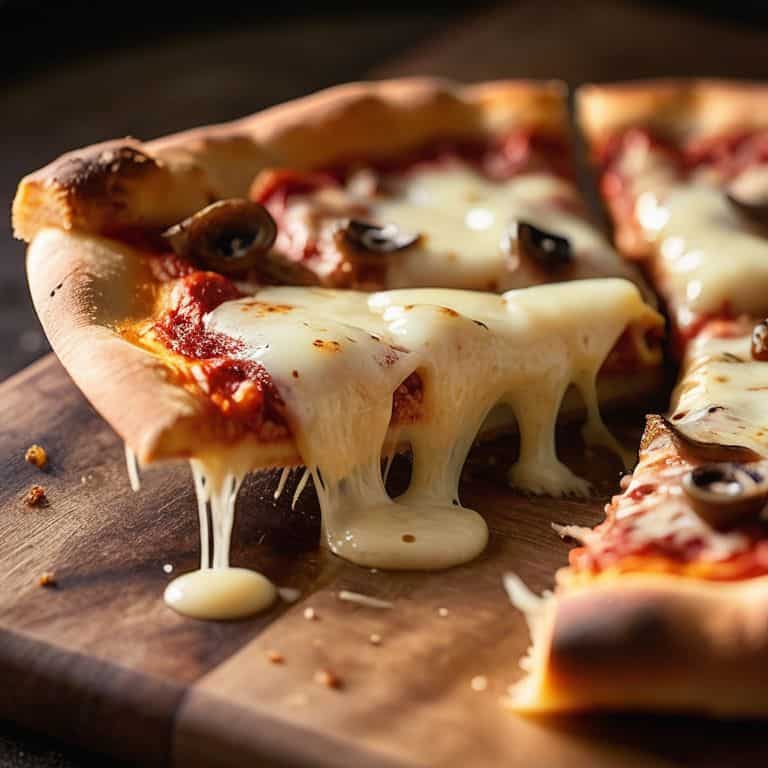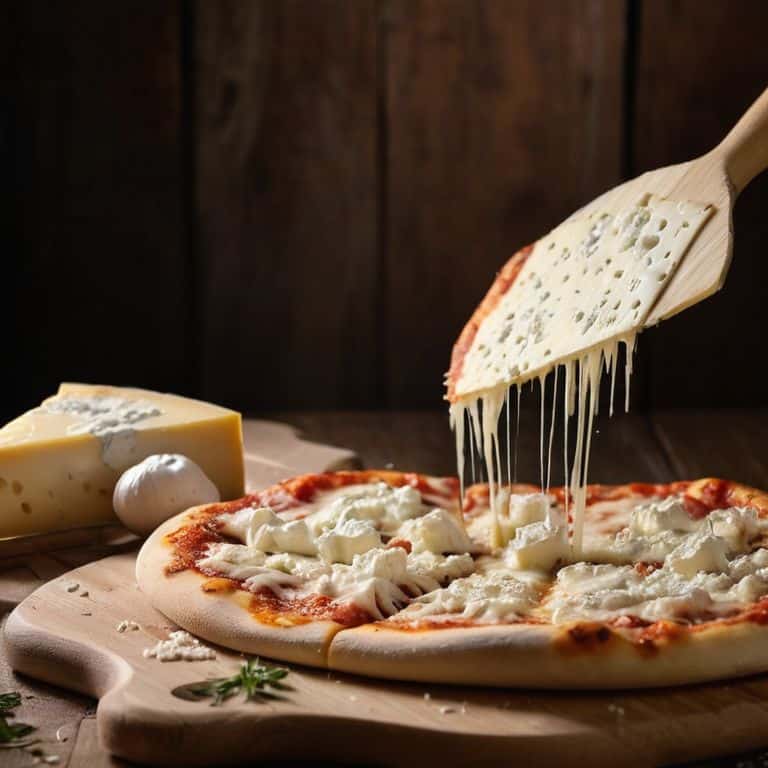I still remember the first time I made a pizza from scratch – the smell of melted mozzarella, the sound of sizzling sauce, and the feeling of biting into a crispy crust. It was love at first bite, and I’ve been on a mission to perfect my pizza game ever since. But let’s get real, folks, the age-old question of what cheese is best for pizza can be overwhelming, with so many options and opinions out there. I’ve tried them all, from gourmet gouda to truffle-infused mozzarella, but at the end of the day, I believe that the best cheese for pizza is the one that makes your taste buds sing.
As a passionate home cook and recipe developer, I’m here to cut through the noise and give you the lowdown on the best cheese for pizza. I’ll share my personal favorites, from classic mozzarella to more adventurous options, and provide you with honest, hype-free advice on how to choose the perfect cheese for your next pizza night. My goal is to empower you to create delicious, satisfying pizzas that will become a staple in your household, just like they have in mine. So, if you’re ready to take your pizza game to the next level, let’s dive in and explore the wonderful world of pizza cheese together!
Table of Contents
What Cheese Is Best for Pizza

When it comes to choosing the perfect cheese for pizza, I always think about the melting point of cheese for pizza. You want a cheese that’s going to melt beautifully and bind all the flavors together. For me, mozzarella is the ultimate choice – it has a relatively low melting point, which makes it perfect for achieving that creamy, stringy texture. I’ve also experimented with other types of cheese, like parmesan and gorgonzola, but there’s something about mozzarella that just feels like home.
As I’ve learned from my culinary school days, the key to a great pizza is often in the cheese combination. Mixing and matching different types of cheese can create a rich, complex flavor profile that elevates the entire dish. I love combining mozzarella with a bit of parmesan for a salty, nutty flavor. And let’s not forget about the importance of cheese browning techniques for pizza – a perfectly browned crust can make all the difference in the world.
In my experience, the best cheese for pizza is one that’s balanced and harmonious. I’m not too concerned with pizza cheese nutrition facts, but I do think about how the cheese will interact with the other ingredients. For a classic margherita pizza, I stick with mozzarella and a bit of parmesan. But for a more adventurous pizza, I might try mixing in some gorgonzola or feta for a tangy, creamy flavor.
Best Cheese Combo for Ultimate Flavor
When it comes to creating the ultimate pizza, I’m all about experimenting with different cheese combinations. I’ve found that mixing and matching can lead to some amazing flavor profiles. For me, the perfect blend is all about finding that perfect balance between creamy and sharp.
My go-to combination is a mix of mozzarella and parmesan, with a sprinkle of freshly grated gouda on top. The way these cheeses melt together is pure magic, and the flavors they bring out in each other are just incredible.
Melting Point Magic for Perfect Cheese
When it comes to achieving that perfect, gooey cheese on your pizza, it’s all about the melting point. I mean, think about it – a good mozzarella or blend can make all the difference in creating a dish that’s both comforting and indulgent. The way the cheese stretches and melts, binding all the flavors together, is just magic.
For me, the key to getting this right is using a combination of cheeses with different melting properties, like mozzarella and parmesan. This creates a beautiful, velvety texture that’s just irresistible. Whether you’re a pizza novice or a seasoned pro, getting the melting point just right can elevate your dish from good to great.
Pizza Cheese Secrets Revealed

As I delve into the world of pizza cheese, I’ve discovered that melting point of cheese for pizza is crucial for achieving that perfect gooey texture. It’s all about finding the right balance, so the cheese melts beautifully without becoming too runny or too hard. I’ve experimented with various types of cheese, and I must say, cheese browning techniques for pizza can make all the difference in adding a rich, caramelized flavor to your pie.
When it comes to combining cheeses, I’m a firm believer in the power of best cheese combination for pizza. Mixing and matching different types of cheese can create a truly unique flavor profile that elevates your pizza game. For instance, pairing mozzarella with a sharper cheese like parmesan can add a nice depth to your pizza. It’s all about finding the right harmony, so don’t be afraid to get creative and experiment with different types of cheese for different pizza styles.
As I continue to perfect my pizza cheese recipes, I’ve also become more mindful of pizza cheese nutrition facts. While it’s true that cheese can be high in calories, there are ways to make your pizza more nutritious without sacrificing flavor. Opting for whole-wheat crusts and loading up on fresh veggies can help balance out the richness of the cheese. And let’s not forget the joy of cheese stretching for perfect pizza – there’s something truly satisfying about watching that melted cheese stretch and pull as you take your first bite.
Cheese Browning Techniques for Crunch
When it comes to achieving that perfect golden-brown crust on your pizza, cheese browning is an art that requires a bit of finesse. I’ve found that the key to getting it just right is to keep an eye on the temperature and cooking time. A slight variation can make all the difference between a beautifully browned crust and a burnt one.
To take your pizza to the next level, try using caramelization techniques to bring out the rich flavors of your cheese. By cooking the pizza at a high temperature for a short amount of time, you can create a crispy, golden-brown crust that’s simply irresistible.
Stretching Cheese for Perfect Pizza
When it comes to stretching cheese for the perfect pizza, I always look for a variety of cheeses that can provide a good balance of flavor and texture. One of my favorite combinations is mozzarella and parmesan, as it gives a nice creaminess to the pizza. I’ve found that using high-quality cheese is essential, and I’m willing to drive a bit further to get the right one.
As I’m stretching the cheese, I love to think about the flavor profile I want to achieve. A good pizza should have a mix of melted, gooey cheese and a bit of crunch from the crust. To get this perfect combination, I make sure to taste the cheese as I go, adjusting the amount and type to get it just right.
My Top 5 Tips for Choosing the Perfect Pizza Cheese

- I always say, you can’t go wrong with a classic mozzarella – it’s the ultimate melting queen!
- Mixing and matching different cheese types is key to achieving that perfect flavor balance – don’t be afraid to get creative!
- A good rule of thumb is to balance soft, mild cheeses with richer, more pungent ones for a beautifully layered taste experience
- If you want that perfect golden-brown crust, make sure to choose a cheese with a high moisture content – it makes all the difference!
- For an extra burst of flavor, try adding some freshly shredded parmesan or romano to your pizza – the salty kick will take it to the next level!
My Top 3 Pizza Cheese Takeaways
I’m obsessed with mozzarella for its melt, but mixing it with parmesan adds a salty, nutty depth that elevates any pizza
Getting the perfect cheese melt is all about the balance between moisture and heat – don’t be afraid to experiment with different temperatures and toppings
For a truly unforgettable pizza, don’t just focus on the type of cheese, but also on the technique: a good cheese stretch or crispy browned crust can make all the difference
The Cheese Connoisseur's Verdict
For me, the best cheese for pizza is the one that tells a story – of creamy textures, of caramelized crusts, and of the love that goes into selecting each wheel, block, or shred, because when it comes to the perfect pie, it’s not just about the cheese, it’s about the journey it takes you on.
Sophie Carter
The Perfect Pie: A Conclusion
As we’ve explored the wonderful world of cheese for pizza, it’s clear that finding the perfect blend is all about balance and harmony. From the melting point magic of mozzarella to the rich flavors of parmesan and gouda, each cheese brings its unique character to the table. We’ve discussed the importance of cheese browning techniques for that perfect crunch and how stretching cheese can make all the difference in your pizza’s texture. Whether you’re a fan of classic combinations or like to experiment with new flavors, the key to an unforgettable pizza is in the cheese.
So, the next time you’re in the kitchen, don’t be afraid to get a little creative with your cheese choices. Remember, the best pizza is the one that’s made with love and a willingness to try new things. As you embark on your own pizza-making journey, keep in mind that practice makes perfect, and the most important ingredient is always your passion. Happy cooking, and let’s get this pizza party started!
Frequently Asked Questions
What's the best way to combine multiple cheeses for a unique pizza flavor?
For me, it’s all about balancing flavors and textures. I love combining creamy mozzarella, tangy feta, and nutty parmesan for a unique twist. The key is to start with a base cheese, like mozzarella, and then add smaller amounts of stronger cheeses to give your pizza depth and intrigue. Experimenting with different ratios is the best way to find your perfect blend!
How does the type of milk used to make the cheese affect the final pizza taste?
The type of milk used to make the cheese can totally transform the flavor of your pizza. I’ve found that cheeses made from cow’s milk, like mozzarella, have a richer, creamier taste, while those from sheep’s or goat’s milk, like feta or chevre, add a tangy, slightly sweet note. It’s all about experimenting to find the perfect fit for your taste buds!
Can I use a combination of soft and hard cheeses for a balanced pizza texture?
Absolutely, I love mixing soft and hard cheeses for a balanced texture! Try pairing creamy mozzarella with a sprinkle of parmesan for a match made in heaven – the softness of mozzarella melts beautifully, while parmesan adds a nice salty crunch.
